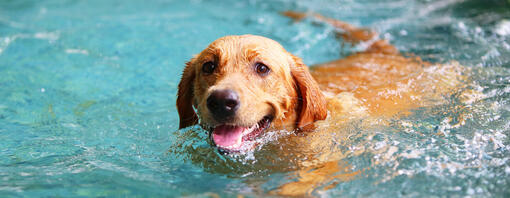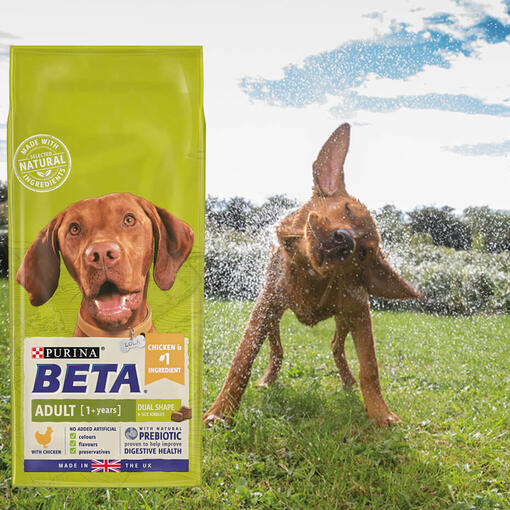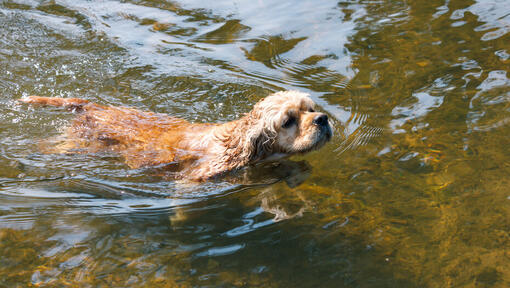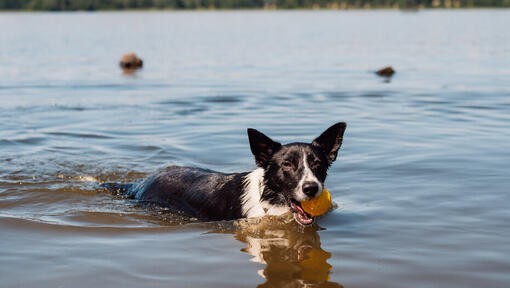


Not all dogs are natural swimmers and their ability and enthusiasm for water vary significantly by breed and individual temperament. While some breeds are natural water lovers others are far less enthusiastic while others will struggle or be unable to swim due to conformation limitations.
For those dogs who love being in the water, introducing your dog to swimming in a controlled environment such a hydrotherapy pool can be great for their wellbeing, providing safe, non-weightbearing exercise that can bring substantial health benefits particularly for older or overweight dogs.
Many of us assume all dogs are natural swimmers, instinctively taking to water with ease. However, this isn't always the case and the reality is that a very small percentage of the nations dogs ever actually get to swim.
Just like humans, dogs have varying comfort levels and abilities when it comes to water, with some breeds being born water lovers and others struggling due to their personality or physical build. This guide will help you understand your dog's potential in the water, explore safe and effective ways to introduce them to swimming, and highlight the benefits and important safety considerations for water-based canine activities.
Can all dogs swim and can dogs swim without being trained?
While we tend to think that all dogs love the water and that swimming is a natural behaviour, this isn’t true. When it comes to water, dogs are a bit like humans in that they’re opinion of the water varies. Most dogs can naturally swim or at least do a doggie paddle if they have to while some breeds really love the water – and for some of those it is something they need an outlet for to keep them healthy, happy and fulfilled. Others due to their size and shape are unable to keep themselves afloat or breathe adequately in the water.
We humans can’t teach a dog to swim - all we can do is give them safe outlets to discover if they enjoy it or not - and if they are going to be canine water babies.
Which breeds are water lovers, and which are water haters?
Some of our best loved breeds started life as water retrieval dogs, fisherman’s helpers or even water rescue dogs. These are the dogs who usually love swimming and nothing makes them happier than being able to be in the water – whether the sea, lakes, rivers or pools.
Water Lovers:
- Labrador Retrievers
- Golden Retriever
- Standard Poodle
- Portuguese Water Dog
- Spanish Water Dog
- Irish Water Spaniel
- Newfoundland
- Curly Coated Retriever
- Chesapeake Bay Retriever
- Flat Coated Retriever
- Lagotto Romagnolo
- Otterhound
- Nova Scotia Duck Tolling Retriever
- Barbet
- Springer Spaniels
Water Haters:
- Dachshunds
- Pugs
- Bulldogs
- Corgis
- Pekinese
- Boston Terrier
- Shih Tzu
- Basset Hound
- Boxers
- Maltese
- French Bulldog
- Chow Chow
- Chihuahua
The ‘water haters’ are dogs that struggle in the water due to their physical build, who are unable to breathe enough to swim safely (brachycephalic breeds) or whose heavy coats weigh them down.
Others can do it but don’t like doing it. There are also some dogs that like doing it – but are no good at it! Dobermanns are one of them. They seem to like the water but then sink more than swim. For these dogs, a life jacket can be transformative.
Should I teach my dog to swim?
It’s a very good question. Most companion dogs will go through their lives never swimming and never having to swim. However if you live or walk near lakes or rivers, own a swimming pool, or want to take your dog on a water based holiday, it is important that they know how to swim in order to be safe – and if you own a water-loving breed, giving them an outlet for this natural behaviour will help keep them happy and healthy.
Beware of the law of unintended consequences though. If you teach your dog to swim and encourage them to go into the water, there is a danger you will create a water-loving monster who will gleefully leap in every muddy puddle, stagnant pond or smelly stream!
And while you may be lucky where you live, many bodies of wild water are not safe to swim in either due to strong currents, pollution, sewage or blue-green algae.
Also remember that we humans can’t teach a dog to swim. All we can do is give them a safe environment to discover for themselves that they can swim and how much fun it can be.
What are the benefits of swimming for dogs?
For water-loving breeds, it is a source of joy, and nothing makes them happier than splashing around and swimming – or retrieving floating toys. Joining their owners in wild swimming is also a great interactive way of keeping fit and building the relationship between you.
For overweight dogs, it is a great form of non weight -bearing exercise that can help them drop the kilos without putting undue strain on their joints.
For older dogs who may have injuries or are just a bit stiff and sore, they can still exercise and have fun with their owners as they do not have to support themselves on old bones and muscles.
If you live near water, just knowing that your dog can swim if they fall in will give you peace of mind and could save their life.
Where can I teach my dog to swim?
It is always best to start off in a controlled environment where you can introduce your dog to the water safely – and ideally with professional help. To do this, there are hydrotherapy pools all over the country where you can give your dog a first taste of real swimming safely, hygienically and without fear of disease or injury.
This will ensure that their first swim will be accompanied by a qualified professional, and they will have a well-fitted canine lifejacket that will give them buoyancy while they discover the joys of the doggy paddle.
The staff at a hydrotherapy pool will be used to helping dogs from the very start learn how to swim – and how to give them the support they need to be confident.
Some dogs will love the whole experience from the very first few moments and be total naturals. Others will take longer to gain confidence. And others will tell you in no uncertain terms, that they are not, and never plan to be, water babies! Many of the companion breeds and the hounds fall into this category. That is fine – at least now you know - but you do need to be watchful in the future if you are around wild water and keep them on the lead if there is any danger of falling in.
Once they have had a session or two, you will know if swimming is going to be something they will love to do in the future – and even if not, at least you know that in an emergency, they know how to swim.
Other places to teach your dog to swim
There are a number of options you could use as teaching sites when considering how to teach your dog how to swim if you do not have access to a hydrotherapy pool
Paddling pools
Small inflatable pools in your garden are a great starting point if you’re getting a puppy (or indeed an older dog) used to water for the first time. This won’t be deep enough to swim in but it is a good introduction into going into water. You can’t expect your dog to be happy swimming out of their depth without first being confident with getting their feet wet – and paddling pools are a great way to introduce this!
Swimming pools
If you have your own swimming pool, consider if you want your dog in it! Lots of people think this is a great idea but the chemicals that you will probably use in your pool to keep it clean for you to swim in, aren’t good for your dog’s coat or skin, and you will have to make sure you wash and shampoo them thoroughly every time they take a dip.
Only do this if there are steps for your dog to enter the water gradually and very shallow areas (no higher than dog elbow depth). Never throw your dog into the pool and assume they will swim – it will scare them and very probably put them off water for life.
If you do have a swimming pool that your dog has access to do not cover it, and make sure there are ramps for your dog to get out. Even good swimmers can drown in swimming pools if they fall or jump in and have no way to get out.
Wild water
If you have shallow bodies of water where you walk (again, no deeper than elbow depth to start with so your dog can stay in their depth), you can encourage your puppy or dog to go in (after toys or just for a paddle) – and if you have other dogs with you who can help show them the way, even better. The very best canine swimming teachers are other dogs.
Find friends whose dogs are water lovers and walk with them. This way your dog can see that it’s safe, be able to approach and retreat as they need while they get their confidence and will associate water with having fun with their friends.
Unless you know your dog can swim well, never let them go into natural bodies of water that have steep sides, that have a muddy bottom, that have ducks etc that might encourage them to chase and swim further than they can swim back. Always keep in your mind “can I get in there and rescue them if I have to?”. People drown every year trying to rescue their dog from water.
As humans, we can’t teach our dogs to swim but we can give them the opportunity to discover their own natural swimming abilities in a safe and encouraging way.
Safety first
An important part of teaching your dog how to swim is keeping their safety – and yours - in mind.
If you are wild swimming with your dog, make sure the water has a solid bottom – not a mud bottom. You can get sucked into the mud and be unable to get out – and if you get out of your depth, this can be highly dangerous. It also means you may not be able to help your dog if they get into difficulties.
If your dog is still a novice, wear a wet suit – as they might try and climb on you for support (and that usually involves claws!). Do not get out of your depth as your dog could push you under the water (a wet dog is heavy!).
Never swim in still water in the summer. The blue-green algae that can accumulate there is highly dangerous and can even be fatal.
For extra security, you can use a flotation vest to support your dog. Make sure it fits your dog properly and put it on your dog before they enter the water. This way, they won't be doing all the work of staying afloat and it will support them if they get tired.
*If you are using swimming as a form of non-weightbearing exercise for an older dog, always use a floatation vest even if they are good swimmers.
What things can I do with my water loving dog?
If you have a dog who loves the water, you will know that they really love the water! Nothing gives them more pleasure than splashing around, playing and swimming in any water they can find.
For these dogs, giving them an outlet for this natural behaviour will transform and enrich their lives, and make them happier and healthier.
There are several sports or activities you can get involved in with your canine water baby.
- Water rescue – the absolute experts at this are Newfoundlands (in fact such is their joy at being canine lifeguards, you have to be a little careful that they don’t ‘rescue’ swimmers who don’t actually want to be rescued!). Just be aware that it will take you about two days to dry off a wet dog with a coat as thick as these water-loving giants.
- Dock diving – this is a competitive activity that involves diving off a dock into a long body of water to retrieve a toy. Sometimes the competition is about speed and other times about distance.
- Paddle boarding and surfing – while this has been popular in Australia for a while, this is fairly new to the UK but if you enjoy water activities, pop a life jacket on your dog and see if they want to join in. There are clubs around the coast that can help get you started.
- Water retrieval – part of a retrieving gundog’s job is to be able to retrieve through water. Find a pet gundog class ( or a working gundog class if your ambitions head in that direction) that uses positive reinforcement methods and as part of their training. T hey will usually include water retrieval.
- Wild swimming – many people have embraced the joys of wild water swimming and this is something that owners can share with their dogs.
Ultimately, understanding your dog's unique relationship with water is the key. Whether you have a natural water enthusiast or a cautious paddler, providing safe and appropriate opportunities for them to interact in water can enrich their lives. For all dogs, knowing they can navigate water safely provides peace of mind for you as an owner. Always prioritise safety, be mindful of environmental hazards, and ensure any water experience is positive.
FAQ
Encouraging your dog to swim can be done at any age and there are no hard and fast rules but if you are visiting a hydrotherapy pool, it is better left until after 16 weeks and check with your vet before you start.
For those dogs who hate water or who don’t have the physical conformation to swim safely, it is extremely stressful. Even for water lovers, it is a fairly intense form of exercise (especially with a thick heavy coat) so it should only be done for short periods of time.

Related articles

















